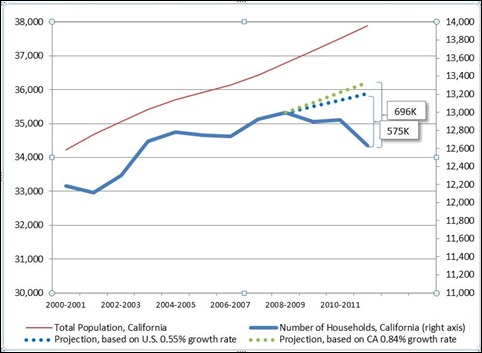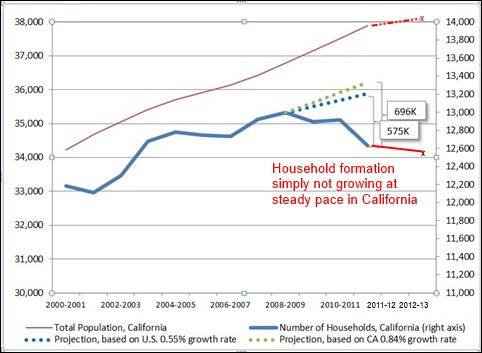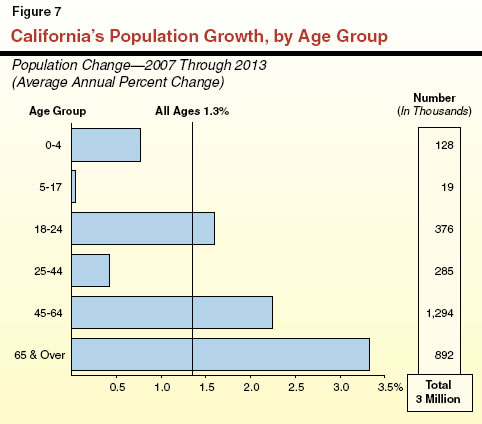Boomers moving back home
The story about adults living at home is no surprise. I caught a clip of Conan O’Brien joking about older Californians moving back home with their parents. So I dug up the latest data on this trend and found some interesting information:
“(LA Times) For seven years through 2012, the number of Californians aged 50 to 64 who live in their parents’ homes swelled 67.6% to about 194,000, according to the UCLA Center for Health Policy Research and the Insight Center for Community Economic Development.This is an incredibly big jump that was hidden in the midst of Millenials moving back home. In total, more than 2.3 million adult children in California are living at home with their parents since the Great Recession hit, a 63 percent increase. This is why household formation in California has been so pathetic. First, take a look at a projection from the California Association of Realtors (CAR) put out two years ago in 2012:
The jump is almost exclusively the result of financial hardship caused by the recession rather than for other reasons, such as the need to care for aging parents, said Steven P. Wallace, a UCLA professor of public health who crunched the data.”

Source: CAR
You can see the “pent up demand” argument here. According to more normal times, you would expect household formation to grow with population growth. This simply did not happen. Given the wickedly low sales volume in the state, having 575,000 or 696,000 additional households would certainly add to demand assuming people could actually afford to buy at current prices (which they can’t). The buyers have largely come from the investor crowd.
So what did happen? I went ahead and pulled up recent Census data and this is how the chart would look like today:

California’s population is now over 38.3 million but look at household formation. Household formation actually fell over this period of time! Why? Because these folks moving back home are largely doing it because of financial struggles, they are not trying to save cash to out compete some house horny home shoppers:
“The numbers are pretty amazing,” Wallace said. “It’s an age group that you normally think of as pretty financially stable. They’re mid-career. They may be thinking ahead toward retirement. They’ve got a nest egg going. And then all of a sudden you see this huge push back into their parents’ homes.”It is fairly clear that this is the primary reason why household formation in the state stinks. Now with investors pulling back, you are seeing inventory pick right back up and sales plunge. Lemmings continue to buy houses but what is new? You are starting to see more data showing how incredibly overvalued some areas of California have become. More and more people are simply stretching their budgets and pouring more of their net income to housing costs.
Many more young adults live with their parents than those in their 50s and early 60s live with theirs. Among 18- to 29-year-olds, 1.6 million Californians have taken up residence in their childhood bedrooms, according to the data.”
In some cases, even higher rents are pushing people back home:
“As with Rohr, those in their 50s move in only as a last resort. Many have exhausted savings. Some have jobs but can’t shoulder soaring rents in areas such as Los Angeles or San Francisco.”This is not a positive trend especially since the fastest growing group in California is the baby boomer group:

Many of these boomers realize that there is no way their kids are going to have the funds to keep this party going (some are “gifting” funds to their kids but this is not the majority for the state). Some think that these boomers will unlock equity and fund their kids. Hah! Most are trying to pay the bills and many are seeing their kids move back home. The study found an astonishing 42 percent of those living at home work (as in 58 percent have no jobs). Forget about buying, these folks can’t even afford rent:
“(CS Monitor) There were 433,000 older adults, age 65 and over, who housed approximately 589,000 of those adult children,” the researchers said in the report released by the UCLA Center for Health Policy Research. Those figures were generated from federal census statistics, said the report’s lead author, Steven P. Wallace.Giant pools of stashed hidden cash? For some but certainly not the larger trend here. If that were the case we would be seeing sales volume surge, wages going up, and a flood of buyers in the overall market. That simply is not happening. The trend is clear and what is left of the middle class in California is getting priced out. I’m sure some will talk about how Newport Coast or Malibu will always be prime but that has always been the case. It isn’t like middle class Californians were targeting these beach cities to begin with. Yet looking at the bigger picture, these macro trends don’t point to a pent up demand of households ready to buy.
Of those adult children living with older parents, researchers found that only about 42 percent were employed, putting a significant strain on the parents to provide not only housing, but also necessities like food, medical care, and transportation for them. To do so for just one adult child, the study found, costs the average couple about 2 1/2 times more per year than they would pay just to take care of themselves.”
No comments:
Post a Comment